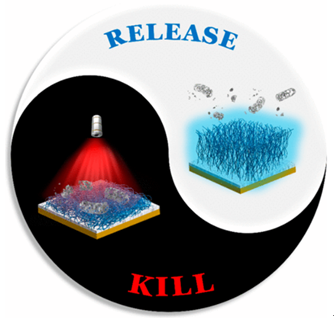Welcome to College of Chemistry, Chemical Engineering and Materials Science of Soochow
University
Smart, Photothermally Activated, Antibacterial Surfaces with Thermally Triggered Bacteria-Releasing Properties
Yaran Wang†, Ting Wei†, Yangcui Qu†, Yang Zhou†, Yanjun Zheng†, Chaobo Huang‡, Yanxia Zhang§, Qian Yu*,†(于谦), and Hong Chen†
† State and Local Joint Engineering Laboratory for Novel Functional Polymeric Materials, College of Chemistry, Chemical Engineering and Materials Science, Soochow University, Suzhou 215123, P. R. China
‡ College of Chemical Engineering, Nanjing Forestry University, Nanjing 210037, P. R. China
§ Institute for Cardiovascular Science and Department of Cardiovascular Surgery of the First Affiliated Hospital, Soochow University, Suzhou 215007, P. R. China
ACS Appl. Mater. Interfaces2020, 12, 21283--21291
The development of effective antibacterial surfaces to prevent the attachment of pathogenic bacteria and subsequent bacterial colonization and biofilm formation is critically important for medical devices and public hygiene products. In the work reported herein, a smart antibacterial hybrid film based on tannic acid/Fe3+ ion (TA/Fe) complex and poly(N-isopropylacrylamide) (PNIPAAm) is deposited on diverse substrates. This surface is shown to have bacteria-killing and bacteria-releasing properties based on, respectively, near-infrared photothermal activation and subsequent cooling. The TA/Fe complex has three roles in this system: (i) as a universal adhesive “anchor” for surface modification, (ii) as a high-efficiency photothermal agent for ablation of attached bacteria (including multidrug resistant bacteria), and (iii) as a robust linker for immobilization of NH2-terminated PNIPAAm via either Michael addition or Schiff base formation. Moreover, because of the thermoresponsive properties of the immobilized PNIPAAm, almost all of the killed bacteria and other debris can be removed from the surface simply by lowering the temperature. It is shown that this hybrid film can maintain good antibacterial performance after being used for multiple “kill-and-release” cycles and can be applied to various substrates regardless of surface chemistry or topography, thus providing a broadly applicable, simple, and reliable solution to the problems associated with surface-attached bacteria in various healthcare applications.

链接:https://pubs.acs.org/doi/abs/10.1021/acsami.9b17581